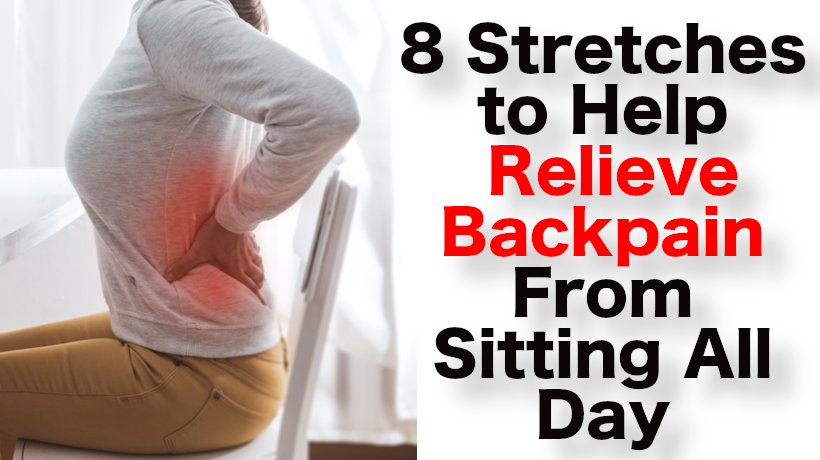Sitting down and becoming inactive is detrimental to our overall health. I can most certainly damage our backsides. This, in turn, leaves us feeling like our backsides are sore all the time. When we use our sit bones a little too often, it creates and puts excess pressure on our lower back, nerves, muscles, and tendons according to Harvard Health. The good news is, there are some exercises to relieve our back pain.
Hamstring stretch
Very Well Fit.com states that The hamstring muscle group is located in the back of your thigh and is responsible for bending or flexing your knee.
- Stand in front of a staircase or low stool.
- Put one foot on the lowest step (or the stool) and lean forward at your hip until you feel a stretch in the back of the thigh in your standing leg.
- Hold the stretch for 20-30 seconds. Repeat three times and then repeat with the other leg.
Knee to Chest
The knee to chest stretch helps to lengthen your back, relieving any pain in the area. To perform the knee-to-chest stretch as instructed by Gavin Van De Walle, MS, RD:
- Lie on your back with your knees bent and your feet flat on the floor.
- Using both hands, grab hold of your right lower leg and interlace your fingers, or clasp your wrists just under the knee.
- While keeping your left foot flat on the floor, gently pull your right knee up to your chest until you feel a slight stretch in your lower back.
- Hold your right knee against your chest for 30–60 seconds, making sure to relax your legs, hips, and lower back.
- Release your right knee and return to the starting position.
- Repeat steps 2–4 with your left leg.
- Repeat three times for each leg.
To make this stretch more difficult, simultaneously bring both of your knees to your chest for 15–20 seconds. Do this 3 times, separated by 30 seconds of rest.
Standing Plank
This stretch is something that you can do anywhere and everywhere. To perform the standing plank all you need to do is:
- With your feet shoulder-width apart, place your hands on a waist-high surface.
- Take a small step back and lift yourself onto the balls of your feet so that your heels are hovering off the ground and your body is leaning slightly forward.
- Press into the surface and hold and breathe for one minute.
Cat-Cow Stretch
The cat-cow stretch helps to strengthen and stretch your back, spine and neck muscles. In doing so, it also helps improve your posture. The Cat-Cow stretch is also known as Chakravakasana in yoga. To perform the Cat-Cow stretch, do these steps in order:
- Get onto your hands and knees with your knees hip-width apart. This is the starting position.
- Arch your back by pulling your belly button up toward your spine, letting your head drop forward. This is the cat portion of the stretch.
- Hold for 5–10 seconds. You should feel a gentle stretch in your lower back.
- Return to the starting position.
- Raise your head and let your pelvis fall forward, curving your back down toward the floor. This is the cow portion of the stretch.
- Hold for 5–10 seconds, then return to the starting position.
- Repeat the cat-cow stretch 15–20 times.
Van De Walle notes you can also perform this exercise in a chair with your feet flat on the floor and your hands on your knees, making it perfect for sneaking in a few stretches at work.
Standing Backbend
The standing backbend is a common yoga and stretching pose that helps to relieve any tension in the neck and shoulders says Alyssa Dodson, San Francisco yoga teacher. Clare Safron-Norton, clinical supervisor of rehabilitation services at Harvard affiliated Bringham and Women’s Hospital says that that exercise stretches the stomach and may help to reduce a bulging disc. To perform the backbend:
- Stand up straight and place the palms of your hands on your lower back, fingers pointing down to the floor.
- Lean backward just a little bit. As you do, press your hands against your back to support it and squeeze your shoulder blades together.
- Hold for a few moments and return to the starting position. Repeat this up to five times.
Seat Forward Bend
This exercise releases the tension in your spine. To perform the seat forward bend:
- Sit on the floor with your legs straight out in front of you.
- Hook a standard bath towel around the bottoms of your feet at the heels.
- Gently bend forward at your hips, bringing your belly down to your thighs.
- Keeping your back straight, grab the towel to help you bring your belly closer to your legs.
- Stretch until you feel mild tension in the back of your legs and lower back.
- Hold for 30 seconds, rest for 30 seconds, and repeat 3 times.
Supported Bridge
The supported bridge works on your lower back to relieve any tension. To do the supported bridge, you must:
- Lie on your back with your knees bent and feet flat on the floor.
- Lift your hips and place a foam roller or firm cushion underneath them.
- Completely relax your body into the support of the floor and the foam roller or firm cushion.
- Hold for 30–60 seconds and repeat 3–5 times, resting 30–60 seconds between sets.
Piriformis Stretch
The piriformis is a small muscle located behind the gluteus maximus (commonly known as the butt). According to writer David Heitz and Gregory Minnis MDT, a healthy piriformis can ease ankle and knee pain. There are two options to performing the stretch. You can either do it sitting on the floor or laying down.
Option 1: Sitting on the floor
- First, roll up a hand towel into a Tootsie Roll shape.
- Next, sit on a firm surface, and find your “butt bones” — the two bones at the lowest part of your posterior.
- Sit directly on top of those bones.
- Then take the towel and place it behind the bones, under your gluteal muscles.
- Once you find that perfect spot perched on the butt bones, contract your abdominals lightly and relax your upper body, especially the shoulders and neck.
- Arch your back by sticking your butt back and out and slightly moving your chest forward.
- In that posture, with your legs flat on the floor, lift your right leg, and place the ankle on the opposite knee.
- Hold for 20 seconds then repeat on the opposite side.
Option 2: Lying Down
- Lying flat on your back, put your arms at your sides with palms facing the floor.
- Positioned about a foot away from the wall, completely extend your legs upward to rest your heels against the wall.
- At that angle, rest one ankle against the opposite knee, just as in the sitting position.
- Hold for 20 seconds then repeat on the opposite side.
What else can I do?
When you sit, you can add a cushion to support your bottom to relieve some tension and pain. Safran-Norton also recommends putting a pillow behind your back for lower back support.
If you can, try to lessen the amount of sitting time throughout the day. Go for a walk in the morning or during your break.



